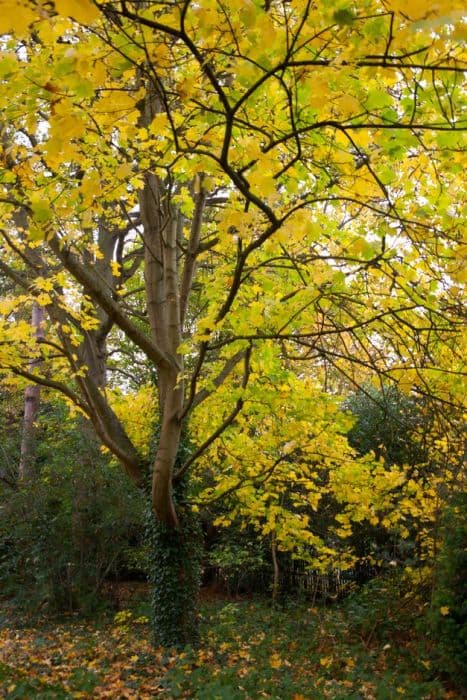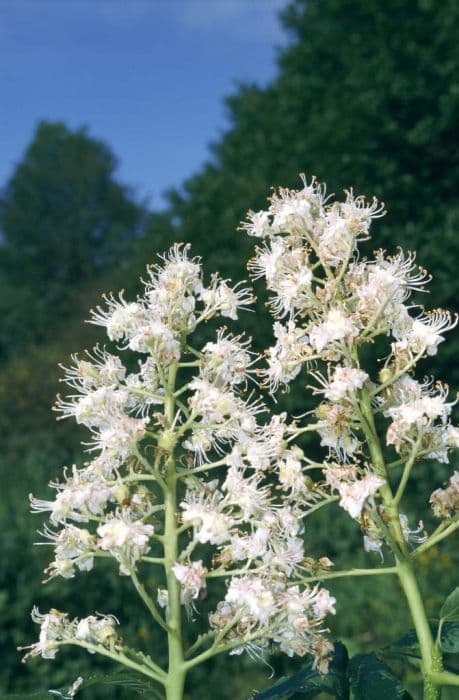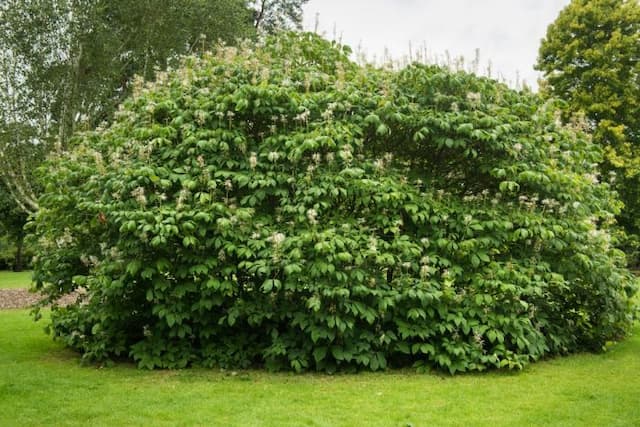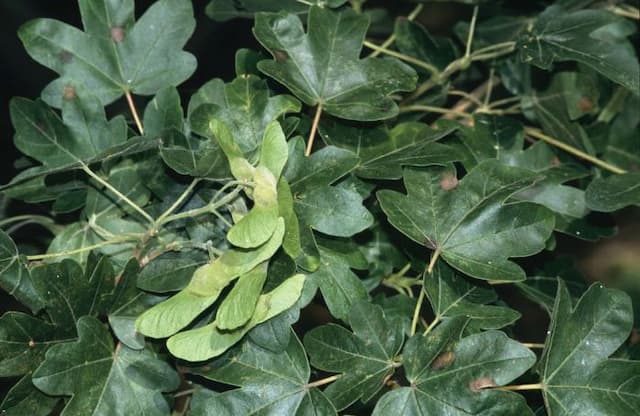Japanese maple Acer palmatum
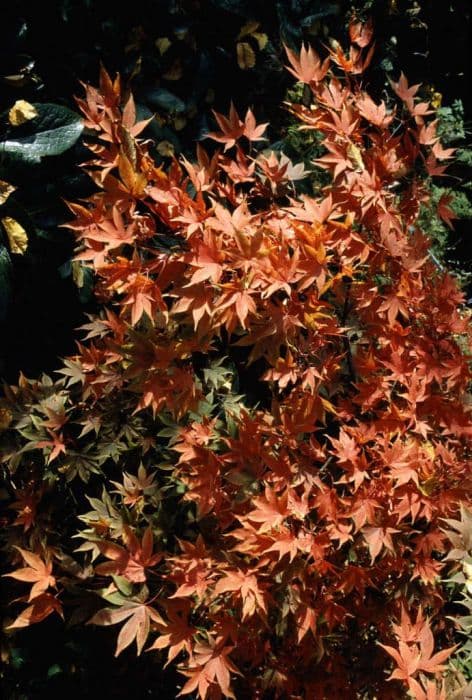
ABOUT
Acer palmatum, commonly known as the Japanese maple, is a plant renowned for its aesthetic appeal and beautiful foliage. The leaves of the Japanese maple are its most distinctive feature, typically shaped like the palm of a hand with pointed, finger-like lobes, often ranging from five to seven or occasionally nine lobes per leaf. The edges of the lobes are finely serrated, giving them a delicate and intricate appearance. The leaves undergo a remarkable color transformation throughout the seasons. In spring, the foliage emerges in shades of bright green or red, depending on the variety. Then as the season progresses into summer, the leaves deepen into darker greens or may retain their reddish hue. Come autumn, the Japanese maple puts on a spectacular display, with leaves turning brilliant shades of yellow, orange, and crimson, providing a striking contrast against the landscape. In addition to the colored leaves, some varieties may display leaves with variegated patterns or different colorations on the underside, adding to the visual interest of the plant. The bark of the Japanese maple is usually smooth and may vary in color from gray to a reddish-brown, sometimes with a noticeable pattern. The overall shape of the Japanese maple depends on the variety, with some forms growing into a rounded, shrub-like shape, while others may have a more upright or cascading form. This diversity in leaf color, texture, bark, and plant shape makes the Japanese maple a prized specimen in gardens, particularly useful for ornamental purposes. The plant's branching structure can also be quite intricate and visually appealing, especially in winter when the leaves have fallen, leaving the elegant tracery of branches on display. The Japanese maple produces small, inconspicuous flowers in the spring, followed by samaras, which are winged seeds that twirl to the ground like tiny helicopters when they fall. While the flowers are not the main attraction, the samaras have a certain charm and add to the plant's ornamental value throughout the growing season. The overall aesthetic of the Japanese maple combines the delicate with the dramatic, making it a cherished plant for gardeners and landscape artists.
About this plant
 Names
NamesFamily
Sapindaceae.
Synonyms
Japanese Maple, Smooth Japanese Maple, Palmate Maple, Japanese Acer.
Common names
Acer palmatum var. amoenum (Carrière) Nicholson, Acer palmatum var. dissectum (Thunb.) Makino, Acer palmatum f. linearilobum (Hayata) H.Hara, Acer palmatum var. matsumurae Koidz., Acer palmatum var. serrulatum (Franch. & Sav.) Makino, Acer palmatum f. amoenum (Carrière) H.Hara, Acer palmatum f. dissectum (Thunb.) H.Hara.
 Toxicity
ToxicityTo humans
The Japanese Maple (Acer palmatum) is generally not considered toxic to humans. There are no significant symptoms of poisoning associated with this plant, as it is not known to possess any components that are harmful when ingested in typical amounts that might occur through casual contact or incidental consumption.
To pets
The Japanese Maple (Acer palmatum) is also generally regarded as non-toxic to pets, including cats and dogs. It does not typically cause serious symptoms of poisoning if pets chew on the leaves or stems. However, as with any non-food plant, ingestion in large quantities could potentially lead to mild gastrointestinal upset.
 Characteristics
CharacteristicsLife cycle
Perennials
Foliage type
Deciduous
Color of leaves
Varies
Height
15-25 feet (4.6-7.6 meters)
Spread
15-25 feet (4.6-7.6 meters)
Plant type
Tree
Hardiness zones
5-8
Native area
Japan Korea China
Benefits
 General Benefits
General Benefits- Aesthetic Appeal: Japanese maple trees are highly valued for their stunning foliage, with a variety of colors ranging from green to deep reds and purples, which change throughout the seasons.
- Landscape Versatility: They can be used in various landscape designs including traditional, contemporary, or Japanese Zen gardens.
- Shade Generation: Depending on the size of the tree, Japanese maples can provide shade in gardens, reducing local temperatures and creating comfortable outdoor spaces.
- Habitat Support: These trees can provide habitat and food for wildlife such as birds and beneficial insects.
- Seasonal Interest: Japanese maples offer year-round interest with their changing leaf colors, delicate flowers in the spring, and interesting branch patterns in the winter after the leaves have fallen.
- Compact Size: They are ideal for smaller gardens or spaces where a full-sized tree would be too large.
- Soil Erosion Control: The root system can help prevent soil erosion in certain landscapes.
- Cultural Significance: They have a rich history in Japanese culture and are often associated with peace and tranquility.
 Medical Properties
Medical Properties- This plant is not used for medical purposes.
 Air-purifying Qualities
Air-purifying QualitiesThis plant is not specifically known for air purifying qualities.
 Other Uses
Other Uses- Artistic inspiration: Japanese maple (Acer palmatum) often features in traditional Japanese art and garden design, providing aesthetic influence and inspiration through its unique shape and foliage.
- Bonsai: The plant is commonly used for bonsai due to its attractive shape, leaf texture, and ability to be trained into miniature forms that mimic mature trees.
- Photography: The vibrant fall colors of the Japanese maple make it a favorite subject for photographers, especially during the autumn season.
- Culture and symbolism: In Japanese culture, the plant is a symbol of peace and serenity. It is often found in places meant for reflection, such as temples and traditional tea gardens.
- Leaf ornaments: The leaves can be pressed and preserved to make natural ornaments or to be used in crafts, due to their distinct shape and color.
- Dye production: The leaves of Japanese maple can be used to produce natural dyes for fabrics, giving them a unique and organic hue.
- Educational tool: Acer palmatum can be used in educational settings to teach about botanical subjects and plant lifecycle, especially in regions where the seasons are pronounced.
- Feng Shui: The Japanese maple is incorporated into Feng Shui practices, where it is valued for its ability to enhance the flow of qi (energy) in a garden setting.
- Culinary uses: Though not as common, the leaves of certain varieties can be used in Japan to wrap food items like mochi, adding a decorative touch and subtle flavor.
- Wine flavoring: In some specialized wine-making processes, parts of the tree could be used to infuse flavors into certain types of Japanese fruit wines.
Interesting Facts
 Feng Shui
Feng ShuiJapanese Maple can be used in Feng Shui to bring calming energy and balance into a garden space. As a plant that symbolizes peace and tranquility, it is often placed in areas where it can help soften sharp corners or act as a focal point to attract positive Chi, promoting a sense of well-being and harmony.
 Zodiac Sign Compitability
Zodiac Sign CompitabilityThe Japanese Maple is not used in astrology practice.
 Plant Symbolism
Plant Symbolism- Elegance: The Acer palmatum, also known as the Japanese Maple, is often associated with grace due to its delicately shaped leaves and the elegant way it changes its color throughout the seasons.
- Peace: In traditional Japanese gardens, the serene presence of the Japanese Maple represents peace and tranquility, inviting contemplation.
- Balance: The tree's harmonious structure symbolizes balance in life, mirroring the Japanese aesthetic of finding beauty in symmetry and equilibrium.
- Endurance: The Japanese Maple has the ability to withstand various climates and conditions, symbolizing the ability to endure challenges.
- Change: With its leaves' changing colors from bright green in spring, to vibrant reds, oranges, and yellows in autumn, the Japanese Maple epitomizes change and the passage of time.
 Water
WaterJapanese Maples should be watered deeply once a week during their growing season in spring and summer, ideally with about 10 gallons each time for established trees in the landscape. In hot and dry climates, they might need additional water, and the frequency can increase to twice per week. During the fall and cooler months, reduce watering to every 2 to 3 weeks, depending on rainfall and soil moisture levels. Young saplings or potted Japanese Maples may require more frequent watering, such as every other day, using about 2 gallons to maintain consistent soil moisture without waterlogging.
 Light
LightJapanese Maples thrive in a spot with dappled sunlight or partial shade, especially in the hot afternoon hours. They can tolerate full sun in milder climates or if adequately watered, but in warmer regions, they prefer some shelter from intense mid-day sun to prevent leaf scorch. Morning sunlight with afternoon shade is a good balance for this plant, ensuring it gets enough light without being damaged by harsh sun.
 Temperature
TemperatureJapanese Maples can survive temperatures as low as 20°F and as high as 90°F. However, the ideal temperature range for a healthy Japanese Maple is between 60°F and 80°F. They can tolerate winter cold better than extreme summer heat; during hot spells, providing shade and ample water can help mitigate stress on the plant.
 Pruning
PruningJapanese Maples benefit from pruning to maintain their shape and to remove any dead or crossed branches, which should be done in late winter or early spring before new growth starts. They can also be lightly pruned in mid-summer if necessary, to thin out dense foliage. It's essential to prune no more than 20-30% of live tissue in one year to avoid stressing the tree.
 Cleaning
CleaningAs needed
 Soil
SoilJapanese Maple thrives in well-draining, fertile soil with a pH range of 5.5 to 6.5. A mix of two parts loamy soil, one part peat moss, and one part pine bark is ideal for ensuring good drainage and aeration while retaining adequate moisture.
 Repotting
RepottingJapanese Maples do not require frequent repotting; young trees may need repotting every 2-3 years, while more mature specimens can go 4-5 years before needing a larger container.
 Humidity & Misting
Humidity & MistingJapanese Maple prefers moderate humidity but is adaptable to a range of conditions. To maintain good health, aim for a humidity level of 40-60%.
 Suitable locations
Suitable locationsIndoor
Provide bright, indirect light and protect from drafts.
Outdoor
Full sun to partial shade; shelter from strong winds.
Hardiness zone
5-8 USDA
 Life cycle
Life cycleThe Japanese maple (Acer palmatum) begins its life cycle as a seed, which after stratification, generally over winter, germinates in spring. The seedling emerges and grows, producing a set of true leaves after the initial cotyledons. As a young sapling, the Japanese maple slowly matures over several years, developing a branching structure and a broader leaf canopy. Once it reaches maturity, which can take 5-10 years, it begins to produce flowers, which are small and often insignificant in appearance. These flowers are followed by the production of samaras, winged seed pods that disperse with the wind to propagate new trees. The Japanese maple's life cycle is perennial, with the tree potentially living and continuing its reproductive cycle for over a century if conditions are conducive to its survival and growth.
 Propogation
PropogationPropogation time
Early spring
Propogation: The Japanese Maple, or Acer palmatum, is commonly propagated through softwood cuttings. The optimal time for this method is during the late spring or early summer months when the tree's new growth is still flexible and not yet fully mature. A cutting, typically 4 to 6 inches (about 10 to 15 centimeters) long taken from a healthy branch, should include at least two to three sets of leaves. The lower leaves are removed, and the cut end of the stem is often dipped in a rooting hormone to encourage root development. The prepared cutting is then inserted into a well-draining growing medium and kept in conditions with high humidity and indirect light. While propagation success rates can vary, providing consistent moisture and warmth will enhance the likelihood of rooting, resulting in new Japanese Maple specimens.



